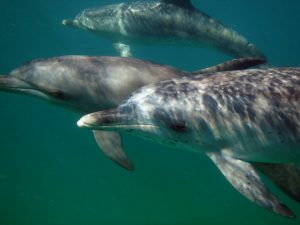
Monday morning started as any other day – we had no idea what was to come! But first, we took care of morning business and then had a great class with Dr. M. We discussed comparative methods when studying animal behavior. We got a quick and dirty summary of dolphin evolution and which showed us how dolphins and cows are “related.” We talked about cladograms, analogous and homologous features and divergent and convergent evolution. We covered ritualization and fixed action patterns; the same behaviors can be brought about by different stimuli. Soon it was lunch and then….
The boat departed at 1500 and we watched the cruise ship start to dock, abort and seemingly keep trying. It was shocking how churned up the water became and how much silt there was in the area. We then rescued a table top (yes, you read that right!) from the sea before continuing in search of dolphins. Soon, we came upon two bottlenose dolphins. These two dolphins were surfing back and forth in the seas. It was interesting to see what behaviors the DCP and boat crew look for to determine if we can get in the water. These dolphins came by the boat as they surfed, but showed no signs of slowing down or interest in the boat. Still, we remained optimistic…
And soon, we saw the elusive Atlantic spotted dolphins! YAY!! We watched them ride the bow and we were amazed at how fast they are! We saw four spotteds, all fairly young. We were all super-duper excited. They came much closer to the boat than either bottlenose dolphin group we’d see previously. They would come to the bow, then swim off and then come rushing back to the boat; they really seemed to enjoy the waves! Even though the waves made us work harder on the boat, it seemed like the dolphins like them. Maybe it even helped them want to interact with us. Once given the word, we all got ready to get in the water…
The water was very, very murky, but it was actually much calmer than our bottlenose dolphin swim last week. From the boat, you could not see the bottom, but we could see the bottom – and the dolphins when they were on the bottom – once we were in the water. The dolphins were everywhere; they were around us and close to use the whole time, twisting and turning. We saw synchronous behavior and pectoral fin rubbing. We saw some rake marks on their skin too. At one point all four juveniles went to the sea floor and they were playing with something. Kel dove down and saw that it was a tiny fish. They weren’t trying to eat it; they seemed content to just chase it around. We noticed that they seem to spend a lot of time investigating Kel and the MVA, and Nicole and her still camera. Do they recognize the DCP team and their equipment? At one point, one juvenile carried a piece of seaweed on its pec fin, dropping it to its fluke. We saw our first dolphin defecation (which of course led to interesting conversations) and saw belly-to-belly swimming. After we couldn’t see them under water, we climbed back aboard and were happy to watch the dolphins follow our boat!
Only a few minutes later we saw another group of dolphins. This time it was a much bigger group, again Atlantic spotted dolphins. We did not have a ton of time to make surface observations, but we could tell that the dolphins were staying very close together and were making a lot of contact with each other. Before hopping in the water, Captain Al gave us some good pointers on how to interact with such a big and lively dolphin group. Our underwater observations gave us much better insight into what they were doing: we heard completely different sounds compared to the previous juvenile group, head to head approaches and even some strong fluke slaps. Two younger dolphins swam away from the group, but not far. They were swimming fast and may have even raked each other and head bumped. It is very challenging to separate rough play from truly aggressive behavior. At one point, a foursome came by us, very, very closely! We got some eye contact and watched the dolphins swim together to the sea floor before surfacing separately. At one point, Sammy thought her mask was flooding – nope! It was tears of joy!
We headed back to the marina and cleaned up for dinner. With free time after dinner, we explored the beach again and found more bioluminescent creatures and our potcake friend! What a great day!
Until tomorrow,
Colonel Potcakes (EKU 2015)
